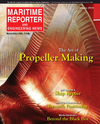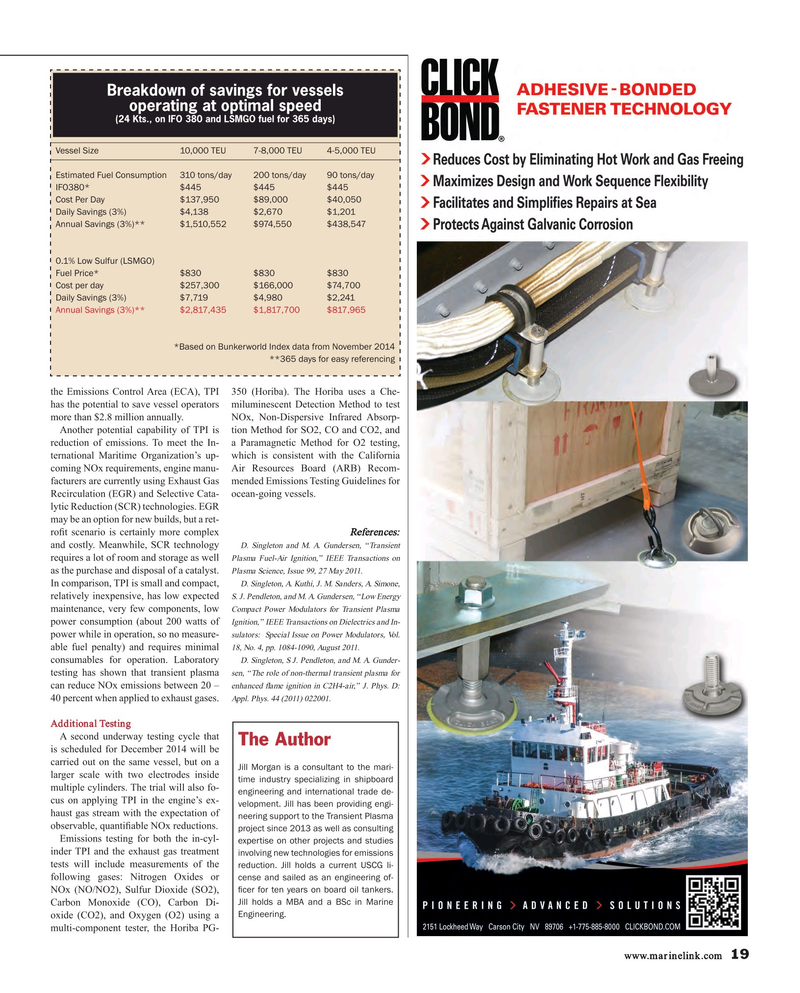
Page 19: of Maritime Reporter Magazine (January 2015)
Ship Repair & Conversion Edition
Read this page in Pdf, Flash or Html5 edition of January 2015 Maritime Reporter Magazine
Breakdown of savings for vessels
Vessels Operating at Optimal Speed – 24 knots operating at optimal speed (24 Kts., on IFO 380 and LSMGO fuel for 365 days)
Vessel Size 10,000 TEU 7-8,000 TEU 4-5,000 TEU
Estimated Fuel Consumption 310 tons/day 200 tons/day 90 tons/day
IFO380* $445 $445 $445
Cost Per Day $137,950 $89,000 $40,050
Daily Savings (3%) $4,138 $2,670 $1,201
Annual Savings (3%)** $1,510,552 $974,550 $438,547 0.1% Low Sulfur (LSMGO)
Fuel Price* $830 $830 $830
Cost per day $257,300 $166,000 $74,700
Daily Savings (3%) $7,719 $4,980 $2,241
Annual Savings (3%)** $2,817,435 $1,817,700 $817,965 *Based on Bunkerworld Index data from November 2014 **365 days for easy referencing the Emissions Control Area (ECA), TPI 350 (Horiba). The Horiba uses a Che- has the potential to save vessel operators miluminescent Detection Method to test more than $2.8 million annually. NOx, Non-Dispersive Infrared Absorp-
Another potential capability of TPI is tion Method for SO2, CO and CO2, and reduction of emissions. To meet the In- a Paramagnetic Method for O2 testing, ternational Maritime Organization’s up- which is consistent with the California coming NOx requirements, engine manu- Air Resources Board (ARB) Recom- facturers are currently using Exhaust Gas mended Emissions Testing Guidelines for
Recirculation (EGR) and Selective Cata- ocean-going vessels.
lytic Reduction (SCR) technologies. EGR may be an option for new builds, but a ret- ro? t scenario is certainly more complex References: and costly. Meanwhile, SCR technology
D. Singleton and M. A. Gundersen, “Transient
Plasma Fuel-Air Ignition,” IEEE Transactions on requires a lot of room and storage as well
Plasma Science, Issue 99, 27 May 2011.
as the purchase and disposal of a catalyst.
D. Singleton, A. Kuthi, J. M. Sanders, A. Simone,
In comparison, TPI is small and compact,
S. J. Pendleton, and M. A. Gundersen, “Low Energy relatively inexpensive, has low expected
Compact Power Modulators for Transient Plasma maintenance, very few components, low
Ignition,” IEEE Transactions on Dielectrics and In- power consumption (about 200 watts of sulators: Special Issue on Power Modulators, Vol. power while in operation, so no measure- 18, No. 4, pp. 1084-1090, August 2011.
able fuel penalty) and requires minimal
D. Singleton, S J. Pendleton, and M. A. Gunder- consumables for operation. Laboratory sen, “The role of non-thermal transient plasma for testing has shown that transient plasma enhanced ? ame ignition in C2H4-air,” J. Phys. D: can reduce NOx emissions between 20 –
Appl. Phys. 44 (2011) 022001.
40 percent when applied to exhaust gases.
Additional Testing
A second underway testing cycle that
The Author is scheduled for December 2014 will be carried out on the same vessel, but on a
Jill Morgan is a consultant to the mari- larger scale with two electrodes inside time industry specializing in shipboard multiple cylinders. The trial will also fo- engineering and international trade de- cus on applying TPI in the engine’s ex- velopment. Jill has been providing engi- haust gas stream with the expectation of neering support to the Transient Plasma observable, quanti? able NOx reductions.
project since 2013 as well as consulting
Emissions testing for both the in-cyl- expertise on other projects and studies inder TPI and the exhaust gas treatment involving new technologies for emissions tests will include measurements of the reduction. Jill holds a current USCG li- following gases: Nitrogen Oxides or cense and sailed as an engineering of- ? cer for ten years on board oil tankers.
NOx (NO/NO2), Sulfur Dioxide (SO2),
Jill holds a MBA and a BSc in Marine
Carbon Monoxide (CO), Carbon Di-
Engineering.
oxide (CO2), and Oxygen (O2) using a multi-component tester, the Horiba PG- www.marinelink.com 19
MR #1 (18-25).indd 19 MR #1 (18-25).indd 19 1/7/2015 9:51:46 AM1/7/2015 9:51:46 AM

 18
18

 20
20
